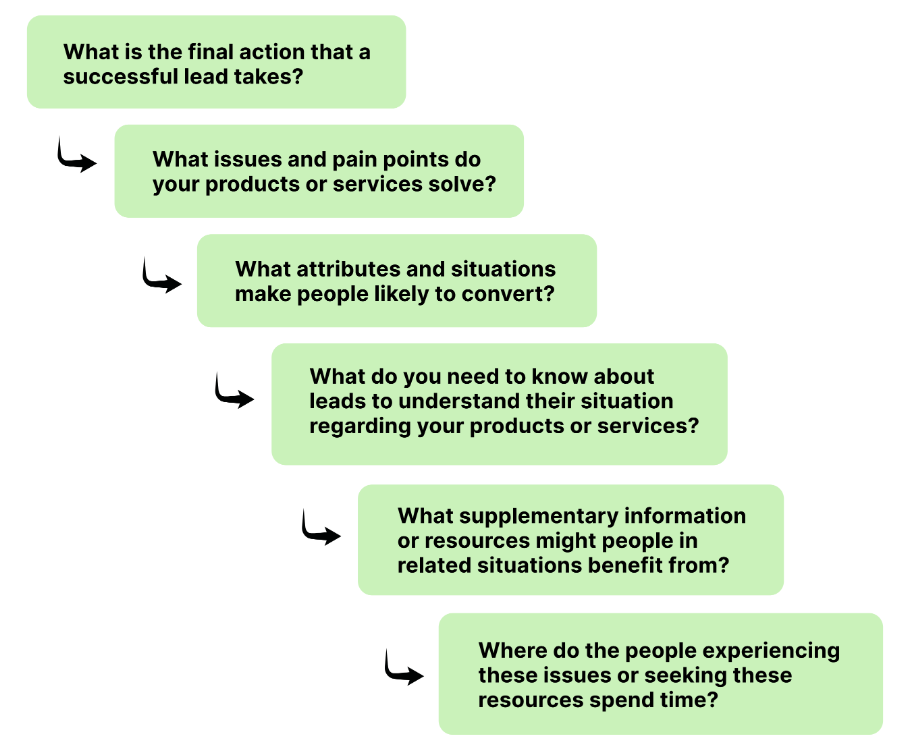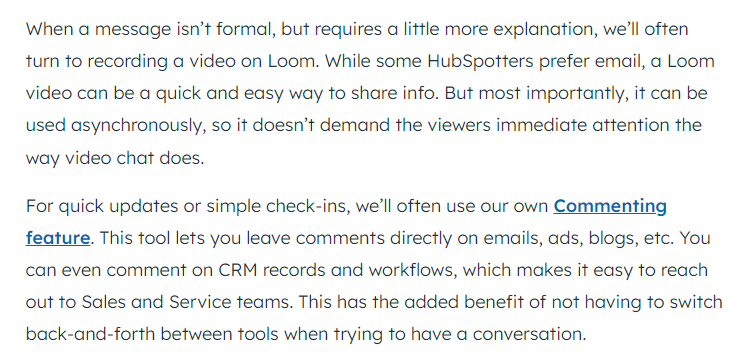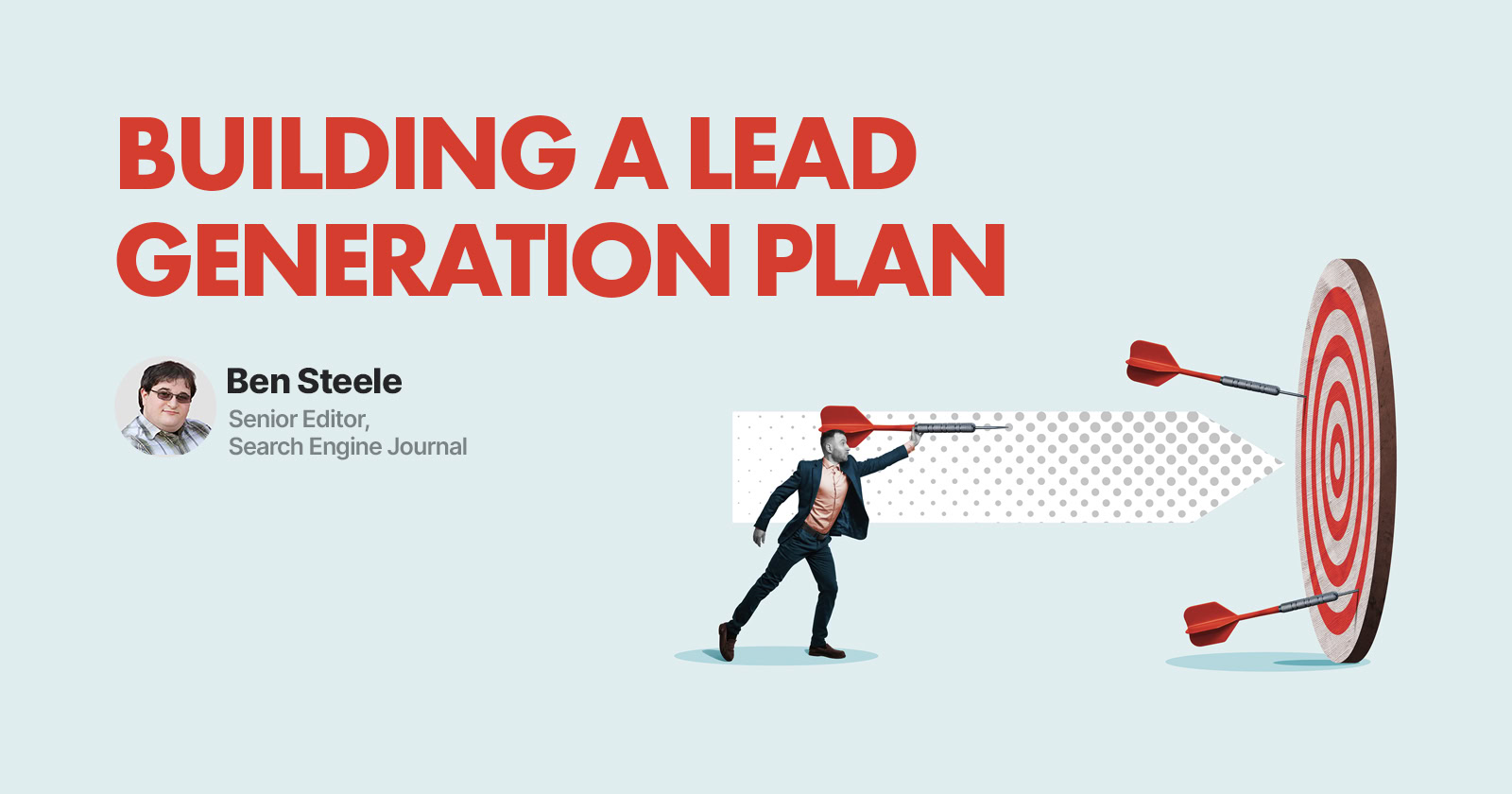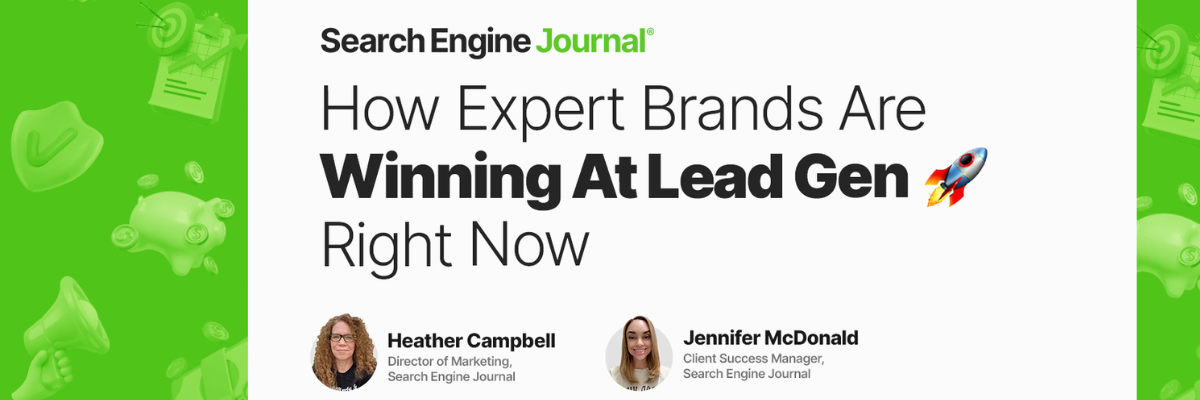This is an excerpt from the B2B Lead Generation ebook, which draws on SEJ’s internal expertise in delivering leads across multiple media types.
You must communicate with leads correctly to provide a good experience and move toward a sale. What that looks like depends on what problems they face, their proximity to readiness to purchase, and how they became a lead.
It helps to start from your end business result and work backward toward your lead.

You need to know exactly what information you need from leads and how to use it to provide them with a good experience.
This helps you understand how to treat leads based on how they first interact with you – and which next steps you can reasonably ask for.
Starting this way also helps you build content that is attractive to leads in the first place. Pushing this line of thought further eventually gets you to SEO content, where it’s helpful to understand people’s specific problems and the intent behind their searches before you begin writing.
The critical distinguishing factor between successful and unsuccessful content is whether you complete the journey from your business goals to your audiences and do the research to understand the situations they’re in, what they need, and what success looks like for them.
“The time to think about business goals is at the start of your content strategy. It’s really easy to fall into the trap of creating content that grabs a lot of eyeballs but contributes nothing to your return on investment (ROI),” says Curtis del Principe, Sr. Marketing Manager at HubSpot.
He adds, “And we’re not immune to that either. We’ve got an old blog from the early days of content marketing (that will remain nameless) that still generates over half a million views per month but nearly zero conversion. And it’s not even in our niche, so you can’t make the argument of brand awareness, either.
But we’re stuck spending time and resources on this blog because if we ever stopped, it would absolutely crater our traffic key performance indicators (KPIs).
The lesson we learned is that you have to start from your business goal – whether that’s leads, sales, signups, or even just brand awareness.
When I’m working on content strategy, I’ll look at what products or offers we want to prioritize this month and then analyze the conversation around them. What questions do consumers have? What comparisons are they making? What pain points are they looking to solve?
Then, you draw a line between those questions and a conversion goal that’s appropriate for that question’s decision stage. Maybe it’s downloading a whitepaper, maybe it’s scheduling a demo, maybe it’s making a sale.
And I find that the act of drawing that line often shows me what shape a piece of content will take. It makes you think about how you’re going to scratch that itch.”
Exclusive Webinar: Learn how we, here at SEJ, create holistic content campaigns to drive leads.
Lead Sources
There are many different sources of leads; not all rely directly on content marketing. Platform ads like Google Discover and social media ads can be very helpful sources of leads. And, of course,
there are the old-fashioned but still relevant direct lead generation techniques, like conferences, cold calling, and direct referrals.
You have many options for targeting and building ads to generate your desired leads. You can usually “qualify” them easily as marketing qualified leads (MQLs) or sales qualified leads (SQLs).
Leads from direct interaction or referrals often communicated with a sales professional already. These are likely sales qualified leads, although they may not always be.
The more direct the lead process, the easier it is to move people in your desired direction.
Generally, you would handle those leads differently than a relationship that begins with organic or gated content.
People coming to you through a content conversion or download can have less predictable journeys, so it’s critical to map their intents and needs to the types of content you create.
For example, at SEJ, we have different types of lead generation products. Here’s a breakdown of two of them:
Webinars
When someone signs up for a webinar, they invest their time into an experience to learn about something specific.
They’re looking for an interactive experience. They might actively have questions about the topic for which they’re seeking a direct answer from an expert.
These make great leads because they’ve already interacted with you after attending a webinar.
Ebooks
Ebooks at SEJ are a little broader. Depending on the scope and topic, an ebook might serve as a teaching tool, a reference guide, or an assistant in setting a strategy.
Someone downloading an ebook could seek a more self-directed experience, and their needs might be less immediate.
These also make great leads because they are invested in learning new things or are seeking help making impactful decisions.
Principe shares, “One of my favorite methods is to mention your offer/tool/product organically within a larger educational topic. For me, that often means discussing how our products or services are used to accomplish our readers’ goals. Here’s an example of that:
 Screenshot from blog.hubspot.com, June 2024
Screenshot from blog.hubspot.com, June 2024Or, it might look like an offer presented as a “pro tip.” In other words, I’m telling you how to do X, Y, and Z … Oh, and pro tip: HubSpot users can do exactly that by going here. Here’s an example of that:
 Screenshot from blog.hubspot.com, June 2024
Screenshot from blog.hubspot.com, June 2024When done right, this tactic helps to give a viewer valuable context for your offer that you simply can’t include in a traditional call to action (CTA). The caveat is that, when done wrong, you end up sounding like a bad 1950s product placement.”
He further explains, “The secret is to forget your marketing vocabulary and talk like you’re explaining it to a friend. If I’m telling a colleague about a great feature, I’m not going to say, ‘Sales Hub’s unique prospecting features enable businesses to optimize your pipeline for conversion,’ right?
The benefit of this tactic is that you tend to get high-intent, low-funnel leads who know exactly what they’re there for. But I will warn that it gets lower overall clicks than a traditional CTA, so you’re definitely trading conversion rate (CVR) for clickthrough rate (CTR).”
This is where you might want to start thinking about software. If you’re just getting started with a lead generation strategy, you might be able to get it by sending lead form responses into spreadsheets and organizing them yourself. If you don’t want to do in-depth lead scoring and only have a couple of different sources of leads, this can work fine.
But even if you’re not engaging in advanced scoring functions, volume will be an issue sooner or later. There’s much to be said for the integration power and quality of life improvements that come with software services.
For now, write down the sources of leads you want to engage with and do the work of understanding what people using those channels want.
Setting Up Your Lead Database
To generate leads using content, you need:
- SEO and social media content to attract interest and generate subscribers.
- Lead generating content that provides value in exchange for information.
- Forms to capture leads. These could be on landing pages that gate off lead generating content or appear alongside/after the content for users to engage with as they read.
- Integration from those forms into the software you choose to manage your leads, whether you’re taking the hands-on approach with spreadsheets or purchasing a service.
- Decisions about how you will categorize and follow up with your leads.
Again, it helps to work in reverse order here. Clarify your process and how you plan to handle leads first.
How you categorize leads and what information you need will guide how you prepare your database. In B2B, some lead sources like referrals and content or LinkedIn ads are likely more valuable to you. A lead from signing up for a free trial of your software is likely much closer to a sale than a lead from downloading a white paper.
Your database is where you will apply qualifications and scoring. It’s also where you decide who should contact a lead and how they should do it.
Depending on the scope of your project, you can run a lead database by hand using a spreadsheet, or use one of many customer relationship management (CRM) software solutions on the market. The advantage of CRM software is automation, especially when it comes to integrating with different potential lead sources.
If you’re running an experiment or just getting started, investing in software may not make sense, but setting up may require more technical skill and a greater ask of your web development team.
Qualifying Leads & Lead Scoring
Qualifying a lead tells you who should reach out to the lead.
Using what you understand about a lead and how they entered your pipeline, you determine how to best engage with and nurture them. They might be ready for sales outreach, or they might only be ready to review more content via an email campaign.
Lead scoring is particularly important for B2B sales. It’s deciding which leads are relevant and how valuable they are. You assign numerical scores to leads based on a variety of attributes and use the numbers to prioritize marketing and sales activities.
This goes hand-in-hand with qualification and helps you prioritize time and resources.
This process alone deserves its own book, but Alex Macura wrote an excellent lead scoring model for us.
We can’t tell you which tool or system to use, but if you know clearly what you want to accomplish and what information you need, you can select the right software more easily.
The core of your model is tags and scores. You should know what specific information you need, and how each piece of information is weighted.
Is There Such Thing As Too Much Information?
When it comes to leads – yes, absolutely.
Some people might balk at that. Today’s marketing advice is full of people saying you must provide tailored and personalized experiences. You must build authentic relationships. And to do that, you need to know as much about people as possible.
Data is power.
To that, I say, sure! That can be true. Sometimes.
But a lead is a transaction. The more information you ask for, the higher the price – both the literal cost of the lead and the price in terms of the value of the information you owe in return.
So, if you ask for too much and give too little, you could be chasing off customers.
In your quest for personalized experiences, are you making your barrier to entry too high?
It depends. (Everyone, get out your SEO bingo cards and cross off “It depends.” It’s next to “high-quality” and the free space.)
Lead generation requires some barriers to entry. That makes a lead a lead: They took an extra step.
There isn’t a single right answer here. If you have an expensive product or service that you only market to executives, it might make sense to either:
- Require a large amount of information to weed out all but the most qualified leads. That way, you waste fewer resources on leads that don’t pan out. However, the leads are more expensive to acquire, and you may miss opportunities to build trust with users further away from purchasing.
- Ask for minimal information from leads because one sale justifies the resources spent on leads that don’t pan out. This way, you don’t miss opportunities to get leads into your database, and you can always score them after the fact to mitigate waste. The risk is in the muddy lead database and potential resource waste.
For example, suppose you screen out Gmail email addresses and only consider leads with company domains. In that case, each lead will be more inherently valuable, but there are also plenty of reasons a potential customer might use their personal email.
This might be the best strategy for you if you don’t have a robust marketing and remarketing strategy to keep leads further away from buying engaged. It might also work well if you’re not using a CRM and scoring leads by hand, so you don’t have to weed out junk.
As you build out your content marketing and upgrade how you handle leads, it might make sense to relax the kinds of leads you accept.
Of course, everyone will have a different happy medium.
On the other hand, asking for more information that disqualifies a large number of leads could be critical to making the best use of your resources.
“When you’re evaluating lead capture, don’t get sucked into focusing on the wrong numbers,” Principe suggests.
“Lead volume seems important on its face, but only if they’re quality leads. I used to work for a medical supply company, and the sales team would constantly complain about uninsured leads. We couldn’t service those customers.
So, we added a field to our lead capture form asking for insurance information. Our form abandonment rate skyrocketed. Our lead volume dropped like a lead balloon. Our sales leaders started to panic.
Until we noticed that our qualification rate went through the roof and took our conversion rate with it. In the end, we boosted our ROI, even while our lead volume decreased.”
It’s a delicate balancing act we’ve been doing at SEJ for a while. When you signed up for our ebooks, you agreed to become a lead for our sponsors and receive their emails.
We like to think that you and readers like you agree to this because we treat you as a reader – and a person first.
This business model works because you’re a valuable reader whether you personally engage with those sponsors or not. We respect you by doing our best to provide valuable content.
We’re confident in the value of our leads because we’re confident in the value of our content. Readers like you trust us to do right by you by providing value for your data and time. Enough valuable readers, treated the right way, eventually become a sale.
More resources:
- Multi-Channel B2B Lead Generation: 8 Steps To Success
- Lead Generation: How To Get Started
- B2B Lead Generation: Create Content That Converts
Featured Image: Ivelin Radkov/Shutterstock






![[SEO, PPC & Attribution] Unlocking The Power Of Offline Marketing In A Digital World](https://www.searchenginejournal.com/wp-content/uploads/2025/03/sidebar1x-534.png)